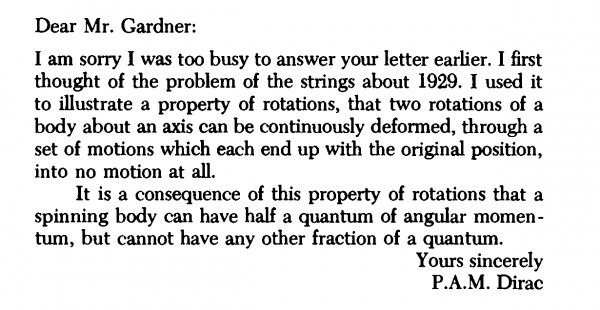I don't think Dirac ever published his trick in his scientific papers and neither in his books, but only used it as a classroom illustration. When Martin Gardner was writing the Mathematical Games column in Scientific American, he contacted Dirac to learn more about his "Scissor Problem," and received the following (typical Dirac) concise and precise reply:

You can find this story, together with an elementary explanation of the trick, in Gardner's popular-level book, "Riddles of the sphinx, and other mathematical puzzle tales," Ch.23. This book is very entertaining and contains many other nice mathematical puzzles for the general public.
Another interesting source is "The Spinor Spanner" by Ethan D. Bolker published in the American Mathematical Monthly where, after talking about a typical neutron interferometer experiment that one read about in introductory quantum mechanics textbooks, one reads: "There is, however, an easy experiment with an analogous outcome. P. A. M. Dirac invented it to lessen, in lectures, the implausibility of the neutron's predicted behavior."
By the way, in the above mentioned notes, Bolker uses Dirac's trick as a motivation to introduce the student to notions of homotopy theory and covering spaces, and you can read it for free in JSTOR here. Also, an excellent discussion of spinors and homotopy in the rotation and Lorentz groups, using again the Dirac's scissor problem as an illustration, can be found in G. Naber's "The Geometry of Minkowski Spacetime," Appendix B. See Google Books here. Another source is M.H.A. Newman's "On a string problem of Dirac."
So, it seems to me that such a trick was, for Dirac, only a classroom explanation, and didn't make it to his Oeuvre, otherwise I would expect one of the above reviews to cite Dirac directly. This is interesting for Dirac fans, since many former students of Dirac claimed that his lectures were too dry, basically repeating the same phrases of his Principles of Quantum Mechanics.
Finally, a similar gedankenexperiment that illustrates a similar point can be found in Sec. 41.5 of Misner, Thorne and Wheller's Gravitation.
 Q&A (4912)
Q&A (4912) Reviews (205)
Reviews (205) Meta (440)
Meta (440) Q&A (4912)
Q&A (4912) Reviews (205)
Reviews (205) Meta (440)
Meta (440)